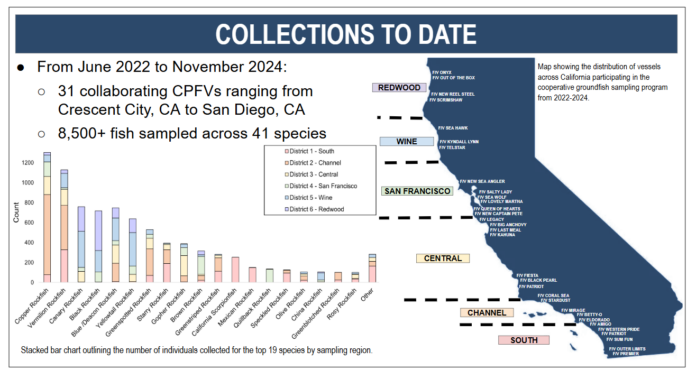RACHEL BROOKS at the National Marine Fisheries Service Southwest Fisheries Science Center Lab, SCRIPPS Institute campus in San Diego provided this graphic of the State and rockfish collected by species and region.
MERIT McCREA
Saltwater Editor
Since 2022 the Sportfishing Association of California (SAC) has spearheaded a cooperative research project on rockfish. To date a total of 32 charter vessels and crews have been working with 7 research labs to gather life-history data on rockfish. This is one of two research projects SAC is currently pursuing – along with gathering tuna lengths so that the total weight in our recreational tuna catch can be estimated from fish counts.
But stepping back, what is life-history information and why does it matter? The simple answer is it’s needed to model the status of a fish stock — how many there are, and how many can be caught.
When there isn’t that information available, these life-history numbers – how quickly fish grow, how old they are when they mature, how many babies they put out in a year – have to be borrowed from other seemingly similar species and populations where those numbers are known.
But that introduces “uncertainty” in the estimates and results in a smaller catch being allowed – lower bag limits, shorter season lengths and potentially closed areas.
In the end the goal of better data is providing fishers with a larger sustainable catch allowance under the law and more certainty that it’s sustainable.
The bottom line is knowing sizes and ages of fish by gender supports fisheries and industry and our food supply.
This writer, along with Rachel Brooks and Dr. Melissa Monk of the National Marine Fisheries Service oversee the rockfish project.
Both Jaime Diamond with Santa Barbara Landing and Erin Villarreal with Mirage Sportfishing were instrumental in getting this rockfish project started back in 2022.
This past year, 2024, there was a total of 24 participating crews out of ports from Crescent City near the Oregon border to San Diego at the Mexican border.
These crews were tasked to sample 50 rockfish, measure whole and turn in tagged carcasses for aging per month. I congratulate and thank each of them for providing an impressive 4,460 specimens of 33 species in 2024, with another estimated 250 or so still to come in.
That brings the total specimens since the project’s inception to more than 8,527.
The 2024 participating science boats included: from Crescent City, Out of the Box Capt. Steve Huber; from Eureka the New Reel Steel, Capt. Tim Klassen, and Scrimshaw – Coastline Charters Capt Marc Schmidt; at Shelter Cove the Sea Hawk and Saylor Ann – Capt. Jake Mitchell; Fort Bragg, Kyndal Lynn, Capt. Kurt Akin; Emeryville, Sea Wolf, Darin Schmicking; Half Moon Bay, New Capt. Pete, Meghan Fox; San Francisco, Lovely Martha, Mike Rescino; Moss Landing, Last Meal, Stephon Parson, Morro Bay, Fiesta, Andrew Oliver; Morro Bay, Black Pearl, Gambit; Avila/Port San Luis, Patriot, “J” Gavin; out of Santa Barara the Coral Sea, Martin Carbajal and Stardust, John “B”; Channel Islands Harbor, Mirage crew; Marina Del Rey, Betty-O Capt. Mike Reinsch; Long Beach Sportfishing, Eldorado, Capt. TJ Schlick; Newport Sportfishing and Davy’s Locker, boats Western Pride, Capt. Mike Harkins and Patriot Capt. Mike Jensen; Dana Wharf Sportfishing boat Sum Fun, Capt. Brian Woolley; San Diego Seaforth Landing, Outer Limits, Capt. Paul Fishcher and at H&M Landing the Premier by Steven Nares.
Each of these boats/crews contributed at least one collection to the effort with several turning in a full sample almost ever month of their season. Capt. Kurt Akin on the 6-pack Kyndall Lynn turned in the most with 14, having double samples several months.
The Mirage crew was next only missing 1 month of their 9-month season. They were tied with Martin Carbajal with the same aboard the Coral Sea.
This project was funded by the Pacific States Marine Fisheries Commission, with support from both SAC and the National Marine Fisheries Service. In addition California’s Ocean Protection Council provided financial support for processing of samples. Also, the California Collaborative Fisheries Research Project contributed many samples to this cooperative effort as well.
In addition to sampling from the recreational catches of anglers, SAC also supports several scientific collecting charters where fish were collected during the closed seasons.
SAC thanks all those anglers who participated in this effort – those that fished on CCFRP charters and those of you who stood by to have their fish measured and specialty cut.
This year SAC and NMFS are adding several outreach fishing trips in an effort to provide youth from under-served and economically disadvantaged communities their first opportunities to catch their own fish from the ocean and introduce them to fisheries science.
I reported on the first of these trips, aboard the Black Pearl out of Morro Bay several weeks ago. It a blast, an unmitigated success thanks to Gambit and the staff at Roosevelt High School in Fresno.
Merit McCrea is saltwater editor for Western Outdoor News. A veteran Southern California partyboat captain, he is a marine research scientist with the Dr. Milton Love Lab at the University of California at Santa Barbara’s Marine Science Institute. He serves on the Groundfish Advisory sub-Panel of the Pacific Fisheries Management Council, the Santa Barbara Harbor Commission, The Channel Islands National Marine Sanctuary Advisory Council and the CCA-Cal State Board. He can be reached at: merit@wonews.com.




